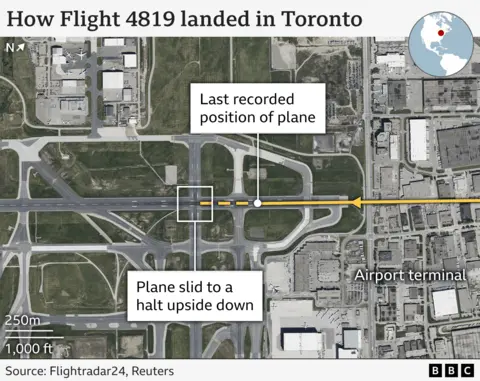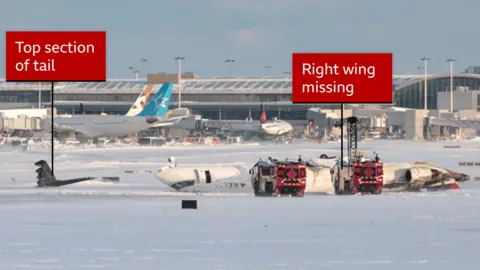Why did a Delta plane crash in Toronto, and how did everyone survive?

Passengers have described their amazement after most of them escaped unscathed from a plane that crash landed in Toronto on Monday afternoon.
The Delta flight skidded along the runway in flames before flipping over and coming to a dramatic halt upside down, losing its tail and an entire wing in the process.
Some of the 80 people on board were then left hanging upside down while still strapped to their seats, before they scrambled over luggage to escape onto the snowy runway.
No deaths have been reported after the incident, which is under investigation.
Analysts have suggested the harsh winter weather may be to blame, or that the plane landed badly. They have also credited the plane’s safety features with saving lives.
What happened when the plane crashed?
The incident took place shortly after 14:00 local time on Monday (19:00 GMT).
It involved a model CRJ-900 plane, operating as Delta Air Lines flight DL4819.
The aircraft arrived at Toronto from the US city of Minneapolis and was carrying 76 passengers and four crew members.
As it landed, the plane appears to have struck the runway, slid for some distance and then flipped over, observed Dan Ronan, a journalist and pilot licensed by the US Federal Aviation Administration (FAA) who spoke to BBC News.

Footage obtained by TMZ showed part of the aircraft bursting into flames as the landing happened. Firefighters rushed to put these out.
Passenger Pete Carlson told broadcaster CBC it was “a very forceful event”, recalling the sound of “concrete and metal” at the moment of impact.
He and others on board were suspended upside down in their seats, and had to release themselves onto the cabin ceiling before leaving the inverted aircraft.
All 80 people on board survived. On Tuesday morning, Delta said 21 injured passengers were initially transported to local hospitals – with 19 later released.
Delta has promised to give more updates.
How does a plane flip over?
BBC Verify has analysed recordings of communications between the plane and air traffic control.
At no point in discussions was there anything to suggest trouble was anticipated with the landing.
This was confirmed by Marco Chan, a former pilot and a senior lecturer at Buckinghamshire New University in the UK, and plane crash investigator Ismo Aaltonen, who also listened to the audio recording.
Mr Chan also said the plane appeared to have made a hard landing – involving an unusually high rate of descent.
It seems to have touched down with one wheel first, Mr Chan told the BBC, which might have caused the landing gear to collapse on impact. This could have lead to the right wing hitting the runway and in turn causing the plane to roll.
The weather may also have been significant. The airport fire chief stated that the runway was dry at the time of the incident.
Airport authorities had said earlier that although recent heavy snow had stopped, “frigid temperatures and high winds [were] moving in”.
As the plane came in to land, air traffic controllers told the pilots of 38mph (61km/h) gusts and the possibility of a “slight bump in the glide path”, CNN reported.
The pilots appear to have attempted what is known as a crab manoeuvre, Mr Ronan said. This involves turning a plane into the wind, and then directly onto the runway at the last moment.
How did everybody on board the plane survive?
“The sheer survivability of this is really amazing,” Mr Ronan told the BBC, pointing out that the aeroplane’s fuselage (body) had stayed intact.
Other commentators hailed the craft’s safety features. CNN analyst and former FAA inspector David Soucie said the plane had broken apart as it had meant to, with the detachment of the wings stopping the fuselage ripping apart.

Graham Braithwaite, professor of safety and accident investigation at the UK’s Cranfield University, said planes were also designed so that air passengers involved in an accident did not hit things likely to cause injury.
“Even the design of the seat back or the tray table is all part of how we consider making that survivable space,” he told the BBC. “And the seatbelt that people have is so important – that is the ultimate thing that stops people being thrown around the cabin like this,” he added.
The flight attendants have also been praised for getting everyone off the flipped aeroplane quickly. Emergency crews on the ground were labelled “heroic” by the airport chief after reaching the crash site in a matter of minutes.
Mr Carlson said the passengers themselves had worked together very effectively. “What I saw was everyone on that plane suddenly became very close in terms of how to help one another, how to console one another,” he said.
How did the seat design help?
Mr Ronan highlighted the importance of the plane’s high-impact 16g seats, which he said were “designed to absorb a great deal of punishment”.
The seats can withstand deceleration of 16 times the force of gravity, and must pass rigorous testing using human dummies to model crash dynamics.
The seat legs, attached to a track on the floor, must be able to pitch down 10 degrees on one side and roll 10 degrees on the other side so that they do not break, said Kevin Campbell, founder of Aviation Consulting & Engineering Solutions, who is FAA-authorised to approve seats that are required to comply with the regulations.
In previous accidents, the FAA had seen seats piled up in the fronts of aircrafts, with bodies still attached in many cases, Mr Campbell said.
Mr Ronan said the regulations keep “the seat in place and bolted to the floor, so you have a higher degree of survivability in your seat itself and you have less likelihood that the seat is going to become detached, where you’re now strapped into a moving object that’s being bounced around the cabin.”
The regulations also require a passenger to be able to withstand hitting their head and legs on the seat in front of them, and seats help absorb weight in their spine so that they do not break their back. Seatbelts are also less stretchy than they used to be so the restraint is more secure.
“As a result of that aircrafts are much, much safer,” Mr Campbell said, and those factors were “absolutely” at play in improving safety in this crash.
“It really is remarkable that the seats did exactly what they were supposed to do, they stayed intact… the seatbelts worked just as they were supposed to, and the seats did not become detached from the floor,” Mr Ronan said.
“Think of how many head injuries we would have had, spinal injuries we would have had, if the seat became detached.”
Which other plane crashes have happened recently?
This marks the fourth major air crash in North America in less than a month, and other recent incidents remain under investigation.
- All 67 people on board a passenger aeroplane and military helicopter died after the two aircraft collided in mid-air near Washington DC on 29 January
- Seven people were killed on 1 February when a medical transportation plane carrying six people crashed in Philadelphia. Another person was killed on the ground
- All 10 people were killed when a small plane came down in Alaska on 6 February
Those incidents followed another high-profile crash in South Korea in December, in which 179 people were killed.
Despite these, experts say air travel remains overwhelmingly safe – and increasingly so.
The US National Transportation Safety Board (NTSB) accident dashboard says there were 257 fatal accidents globally in 2024, compared with 362 in 2014.
Additional reporting by Mallory Moench, Tom Joyner and Josh Cheetham
World News || Latest News || U.S. News
Source link




